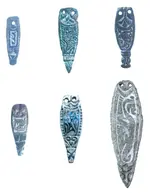Digger the dectorist
Jr. Member
Found this today what you think?
Looks to be saxon/viking.
Looks to be saxon/viking.
Attachments
Upvote
15
Nice piece. I am no expert, but there will be a very knowledgeable person along soon to help you. What material is that? General location you found it, like north or south of England. Thanks for posting and again, nice find.Found this today what you think?
Looks to be saxon/viking.
Where would it be if it was south of England.Nice piece. I am no expert, but there will be a very knowledgeable person along soon to help you. What material is that? General location you found it, like north or south of England. Thanks for posting and again, nice find.
Red coat will be along to say what it is. I would think Saxon too but not my Forte. Not sure I have a Forte although I did own a Ford once.Where would it be if it was south of England.
Just ribbing ya. 😅
If I had dug it, first inclination wold be Saxon.
Awesome
Oxfordshire i found it with all these bits today another good day.Where would it be if it was south of England.
Just ribbing ya. 😅
If I had dug it, first inclination wold be Saxon.
Awesome recovery 👏

Nice find.
You’ve already tagged it as a “strap end”, which is what it is. Used as semi-functional decorative terminals on various belts, straps and thongs throughout the Anglo-Saxon period, most usually for personal clothing. This kind of thing:
View attachment 2010900
I don’t think there’s anything definitive about the decoration which would specifically give it Viking attribution, although that doesn’t preclude it being ‘Viking Era’.
I assume it’s a ‘one-piece’ casting and not a composite but could we see the other side please, and does it have a ‘split’ in the butt end? Late Anglo-Saxon and Viking-age strap-ends most commonly have a split into which the strap was inserted and then riveted in place through the hole(s). Later (10th century) strap-ends can be more robustly made, with just a recess on the reverse of the butt end to take the strap, but then often have multiple rivet holes.
Thanks for the infoYep, that's the 'split' I was referring to, and what i hoped to see.
View attachment 2010915
As I said, it's the typical form for late Anglo-Saxon and Viking-age strap ends. But it's still the case that "Viking-age" is not the same thing as "Viking-made".
Nice!!! Congrats!!! Looks Old!!!Found this today what you think?
Looks to be saxon/viking.
